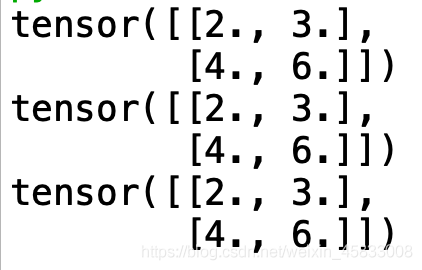жӮЁеҘҪпјҢзҷ»еҪ•еҗҺжүҚиғҪдёӢи®ўеҚ•е“ҰпјҒ
дҪҝз”ЁPyTorchжұӮе№іж–№ж №жҠҘй”ҷеҰӮдҪ•и§ЈеҶіпјҹй’ҲеҜ№иҝҷдёӘй—®йўҳпјҢиҝҷзҜҮж–Үз« иҜҰз»Ҷд»Ӣз»ҚдәҶзӣёеҜ№еә”зҡ„еҲҶжһҗе’Ңи§Јзӯ”пјҢеёҢжңӣеҸҜд»Ҙеё®еҠ©жӣҙеӨҡжғіи§ЈеҶіиҝҷдёӘй—®йўҳзҡ„е°ҸдјҷдјҙжүҫеҲ°жӣҙз®ҖеҚ•жҳ“иЎҢзҡ„ж–№жі•гҖӮ
еҲқжӯҘдҪҝз”ЁPyTorchиҝӣиЎҢе№іж–№ж №и®Ўз®—пјҢйҖҡиҝҮrange()еҲӣе»әдёҖдёӘеј йҮҸпјҢ然еҗҺеҜ№е…¶жұӮе№іж–№ж №гҖӮ
a = torch.tensor(list(range(9))) b = torch.sqrt(a)
жҠҘеҮәд»ҘдёӢй”ҷиҜҜпјҡ
RuntimeError: sqrt_vml_cpu not implemented for 'Long'
Longзұ»еһӢзҡ„ж•°жҚ®дёҚж”ҜжҢҒlogеҜ№ж•°иҝҗз®—, дёәд»Җд№ҲTensorжҳҜLongзұ»еһӢ? еӣ дёәеҲӣе»әListж•°з»„ж—¶й»ҳи®ӨдҪҝз”Ёзҡ„жҳҜint, жүҖд»Ҙд»ҺListиҪ¬жҲҗtorch.TensorеҗҺ, ж•°жҚ®зұ»еһӢеҸҳжҲҗдәҶLongгҖӮ
print(a.dtype)
torch.int64
жҸҗеүҚе°Ҷж•°жҚ®зұ»еһӢжҢҮе®ҡдёәжө®зӮ№еһӢ, йҮҚж–°жү§иЎҢпјҡ
b = torch.sqrt(a.to(torch.double)) print(b)
tensor([0.0000, 1.0000, 1.4142, 1.7321, 2.0000, 2.2361, 2.4495, 2.6458, 2.8284], dtype=torch.float64)
иЎҘе……пјҡpytorch20 pytorchеёёи§Ғиҝҗз®—иҜҰи§Ј
иҝҷдёӘжҳҜзҹ©йҳөпјҲеј йҮҸпјүжҜҸдёҖдёӘе…ғзҙ дёҺж ҮйҮҸиҝӣиЎҢж“ҚдҪңгҖӮ
import torch a = torch.tensor([1,2]) print(a+1) >>> tensor([2, 3])
иҝҷдёӘе°ұжҳҜдёӨдёӘзӣёеҗҢе°әеҜёзҡ„еј йҮҸзӣёд№ҳпјҢ然еҗҺеҜ№еә”е…ғзҙ зҡ„зӣёд№ҳе°ұжҳҜиҝҷдёӘе“ҲиҫҫзҺӣз§ҜпјҢд№ҹжҲҗдёәelement wiseгҖӮ
a = torch.tensor([1,2]) b = torch.tensor([2,3]) print(a*b) print(torch.mul(a,b)) >>> tensor([2, 6]) >>> tensor([2, 6])
иҝҷдёӘtorch.mul()е’Ң*жҳҜзӯүд»·зҡ„гҖӮ
еҪ“然пјҢйҷӨжі•д№ҹжҳҜзұ»дјјзҡ„пјҡ
a = torch.tensor([1.,2.]) b = torch.tensor([2.,3.]) print(a/b) print(torch.div(a/b)) >>> tensor([0.5000, 0.6667]) >>> tensor([0.5000, 0.6667])
жҲ‘们еҸҜд»ҘеҸ‘зҺ°зҡ„torch.div()е…¶е®һе°ұжҳҜ/, зұ»дјјзҡ„пјҡtorch.addе°ұжҳҜ+,torch.sub()е°ұжҳҜ-,дёҚиҝҮз¬ҰеҸ·зҡ„иҝҗз®—жӣҙз®ҖеҚ•еёёз”ЁгҖӮ
еҰӮжһңжҲ‘们жғіе®һзҺ°зәҝжҖ§д»Јж•°дёӯзҡ„зҹ©йҳөзӣёд№ҳжҖҺд№ҲеҠһе‘ўпјҹ
иҝҷж ·зҡ„ж“ҚдҪңжңүдёүдёӘеҶҷжі•:
torch.mm()
torch.matmul()
@пјҢиҝҷдёӘйңҖиҰҒи®°еҝҶпјҢдёҚ然йҒҮеҲ°иҝҷдёӘеҸҜиғҪдјҡжҢәи’ҷи”Ҫзҡ„
a = torch.tensor([[1.],[2.]]) b = torch.tensor([2.,3.]).view(1,2) print(torch.mm(a, b)) print(torch.matmul(a, b)) print(a @ b)

иҝҷжҳҜеҜ№дәҢз»ҙзҹ©йҳөиҖҢиЁҖзҡ„пјҢеҒҮеҰӮеҸӮдёҺиҝҗз®—зҡ„жҳҜдёҖдёӘеӨҡз»ҙеј йҮҸпјҢйӮЈд№ҲеҸӘжңүtorch.matmul()еҸҜд»ҘдҪҝз”ЁгҖӮзӯүзӯүпјҢеӨҡз»ҙеј йҮҸжҖҺд№ҲиҝӣиЎҢзҹ©йҳөзҡ„д№ҳжі•пјҹеңЁеӨҡз»ҙеј йҮҸдёӯпјҢеҸӮдёҺзҹ©йҳөиҝҗз®—зҡ„е…¶е®һеҸӘжңүеҗҺдёӨдёӘз»ҙеәҰпјҢеүҚйқўзҡ„з»ҙеәҰе…¶е®һе°ұеғҸжҳҜзҙўеј•дёҖж ·пјҢдёҫдёӘдҫӢеӯҗпјҡ
a = torch.rand((1,2,64,32)) b = torch.rand((1,2,32,64)) print(torch.matmul(a, b).shape) >>> torch.Size([1, 2, 64, 64])

a = torch.rand((3,2,64,32)) b = torch.rand((1,2,32,64)) print(torch.matmul(a, b).shape) >>> torch.Size([3, 2, 64, 64])
иҝҷж ·д№ҹжҳҜеҸҜд»Ҙзӣёд№ҳзҡ„пјҢеӣ дёәиҝҷйҮҢж¶үеҸҠдёҖдёӘиҮӘеҠЁдј ж’ӯBroadcastingжңәеҲ¶пјҢиҝҷдёӘеңЁеҗҺйқўдјҡи®ІпјҢиҝҷйҮҢе°ұзҹҘйҒ“пјҢеҰӮжһңиҝҷз§Қжғ…еҶөдёӢпјҢдјҡжҠҠbзҡ„第дёҖз»ҙеәҰеӨҚеҲ¶3ж¬Ў пјҢ然еҗҺеҸҳжҲҗе’ҢaдёҖж ·зҡ„е°әеҜёпјҢиҝӣиЎҢзҹ©йҳөзӣёд№ҳгҖӮ
print('е№Ӯиҝҗз®—')
a = torch.tensor([1.,2.])
b = torch.tensor([2.,3.])
c1 = a ** b
c2 = torch.pow(a, b)
print(c1,c2)
>>> tensor([1., 8.]) tensor([1., 8.])е’ҢдёҠйқўдёҖж ·пјҢдёҚеӨҡиҜҙдәҶгҖӮејҖж–№иҝҗз®—еҸҜд»Ҙз”Ёtorch.sqrt()пјҢеҪ“然д№ҹеҸҜд»Ҙз”Ёa**(0.5)гҖӮ
еңЁдёҠеӯҰзҡ„ж—¶еҖҷпјҢжҲ‘们зҹҘйҒ“lnжҳҜд»Ҙeдёәеә•зҡ„пјҢдҪҶжҳҜеңЁpytorchдёӯпјҢ并дёҚжҳҜиҝҷж ·гҖӮ
pytorchдёӯlogжҳҜд»ҘeиҮӘ然数дёәеә•ж•°зҡ„пјҢ然еҗҺlog2е’Ңlog10жүҚжҳҜд»Ҙ2е’Ң10дёәеә•ж•°зҡ„иҝҗз®—гҖӮ
import numpy as np
print('еҜ№ж•°иҝҗз®—')
a = torch.tensor([2,10,np.e])
print(torch.log(a))
print(torch.log2(a))
print(torch.log10(a))
>>> tensor([0.6931, 2.3026, 1.0000])
>>> tensor([1.0000, 3.3219, 1.4427])
>>> tensor([0.3010, 1.0000, 0.4343]).ceil() еҗ‘дёҠеҸ–ж•ҙ
.floor()еҗ‘дёӢеҸ–ж•ҙ
.trunc()еҸ–ж•ҙж•°
.frac()еҸ–е°Ҹж•°
.round()еӣӣиҲҚдә”е…Ҙ
.ceil() еҗ‘дёҠеҸ–ж•ҙ.floor()еҗ‘дёӢеҸ–ж•ҙ.trunc()еҸ–ж•ҙж•°.frac()еҸ–е°Ҹж•°.round()еӣӣиҲҚдә”е…Ҙ
a = torch.tensor(1.2345) print(a.ceil()) >>>tensor(2.) print(a.floor()) >>> tensor(1.) print(a.trunc()) >>> tensor(1.) print(a.frac()) >>> tensor(0.2345) print(a.round()) >>> tensor(1.)
иҝҷдёӘжҳҜи®©дёҖдёӘж•°пјҢйҷҗеҲ¶еңЁдҪ иҮӘе·ұи®ҫзҪ®зҡ„дёҖдёӘиҢғеӣҙеҶ…[min,max],е°ҸдәҺminзҡ„иҜқе°ұиў«и®ҫзҪ®дёәminпјҢеӨ§дәҺmaxзҡ„иҜқе°ұиў«и®ҫзҪ®дёәmaxгҖӮиҝҷдёӘж“ҚдҪңеңЁдёҖдәӣеҜ№жҠ—з”ҹжҲҗзҪ‘з»ңдёӯпјҢеҘҪеғҸжҳҜWGAN-GP,йҖҡиҝҮејәиЎҢйҷҗеҲ¶жЁЎеһӢзҡ„еҸӮж•°зҡ„еҖјгҖӮ
a = torch.rand(5) print(a) print(a.clamp(0.3,0.7))

1.PyTorchжҳҜзӣёеҪ“з®ҖжҙҒдё”й«ҳж•Ҳеҝ«йҖҹзҡ„жЎҶжһ¶пјӣ2.и®ҫи®ЎиҝҪжұӮжңҖе°‘зҡ„е°ҒиЈ…пјӣ3.и®ҫи®Ўз¬ҰеҗҲдәәзұ»жҖқз»ҙпјҢе®ғи®©з”ЁжҲ·е°ҪеҸҜиғҪең°дё“жіЁдәҺе®һзҺ°иҮӘе·ұзҡ„жғіжі•пјӣ4.дёҺgoogleзҡ„Tensorflowзұ»дјјпјҢFAIRзҡ„ж”ҜжҢҒи¶ід»ҘзЎ®дҝқPyTorchиҺ·еҫ—жҢҒз»ӯзҡ„ејҖеҸ‘жӣҙж–°пјӣ5.PyTorchдҪңиҖ…дәІиҮӘз»ҙжҠӨзҡ„и®әеқӣ дҫӣз”ЁжҲ·дәӨжөҒе’ҢжұӮж•ҷй—®йўҳ6.е…Ҙй—Ёз®ҖеҚ•
е…ідәҺдҪҝз”ЁPyTorchжұӮе№іж–№ж №жҠҘй”ҷеҰӮдҪ•и§ЈеҶій—®йўҳзҡ„и§Јзӯ”е°ұеҲҶдә«еҲ°иҝҷйҮҢдәҶпјҢеёҢжңӣд»ҘдёҠеҶ…е®№еҸҜд»ҘеҜ№еӨ§е®¶жңүдёҖе®ҡзҡ„её®еҠ©пјҢеҰӮжһңдҪ иҝҳжңүеҫҲеӨҡз–‘жғ‘жІЎжңүи§ЈејҖпјҢеҸҜд»Ҙе…іжіЁдәҝйҖҹдә‘иЎҢдёҡиө„и®Ҝйў‘йҒ“дәҶи§ЈжӣҙеӨҡзӣёе…ізҹҘиҜҶгҖӮ
е…ҚиҙЈеЈ°жҳҺпјҡжң¬з«ҷеҸ‘еёғзҡ„еҶ…е®№пјҲеӣҫзүҮгҖҒи§Ҷйў‘е’Ңж–Үеӯ—пјүд»ҘеҺҹеҲӣгҖҒиҪ¬иҪҪе’ҢеҲҶдә«дёәдё»пјҢж–Үз« и§ӮзӮ№дёҚд»ЈиЎЁжң¬зҪ‘з«ҷз«ӢеңәпјҢеҰӮжһңж¶үеҸҠдҫөжқғиҜ·иҒ”зі»з«ҷй•ҝйӮ®з®ұпјҡis@yisu.comиҝӣиЎҢдёҫжҠҘпјҢ并жҸҗдҫӣзӣёе…іиҜҒжҚ®пјҢдёҖз»ҸжҹҘе®һпјҢе°Ҷз«ӢеҲ»еҲ йҷӨж¶үе«ҢдҫөжқғеҶ…е®№гҖӮ
жӮЁеҘҪпјҢзҷ»еҪ•еҗҺжүҚиғҪдёӢи®ўеҚ•е“ҰпјҒ